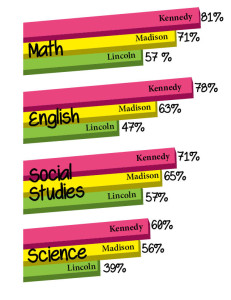
Transitioning from middle school to high school is a big change. The school building is bigger, the classrooms are farther apart, the hallways are more crowded and the classes get harder. This poses the question: Are middle school students prepared for high school?
Three junior highs feed into Central: Lincoln, Madison and part of Kennedy. They are all part of District 203, a unit district, which means that all primary schools as well as high schools are under the same leadership. According to Jackie Thornton, assistant principal for curriculum, this is beneficial for students and teachers alike.
“We know that the curriculum is aligned to our high school expectations because we have curriculum that’s developed from early childhood all the way to grade 12,” Thornton said. “It’s our assumption that students who come to us have successfully completed that junior high curriculum and they are ready for high school.”
But how do Central students feel about their junior high experience? To answer this question, Central Times surveyed students at the school. Students were asked how well they thought the middle school they attended prepared them for high school in the four core areas: science, math, English and social studies. 435 students responded to the survey. By selecting “strongly agree,” “agree,” “disagree” or “strongly disagree” they expressed their opinion about four statements: “Middle school prepared me very well for high school math/English/social studies/science classes.”
Of the 435 students, 106 students came from Kennedy, 142 from Lincoln, 150 from Madison and 37 came from schools outside the district. Responders represented all four grades as well: 58 freshmen, 134 sophomores, 104 juniors and 139 seniors were surveyed.
Overall, the students felt most prepared for high schools math classes, and least prepared for science classes. The front page graph also shows that no matter the subject, more students from Kennedy agreed to the statements in the survey than students from Madison or Lincoln. This is consistent with results from some of the tests the district conducted recently.
School district 203 uses a variety of methods to asses how prepared students are for high school, including district benchmark assessments and the ISAT and Explore tests. According to Timothy Wierenga, assistant superintendent for assessment and analytics, curriculum benchmark assessments are used in all schools in the district to see if students have mastered subject areas. This allows each of the schools to see if any changes need to be made to prepare students on their path to high school.
Explore and ISAT—Illinois Standards Achievement Test— results are another factor used to determine how prepared students are for high school. Students take these tests during eighth grade. According to Thornton, Explore test results are used to “help determine which students might need additional support in reading or math,” and whether they need to be placed into support programs in high school. At the national level the Explore test is generally administered to 9th graders, but District 203 believes that students and schools would benefit the most by giving the test to eighth graders.
“It’s the ceiling effect: we’d have too many kids hitting that ceiling [in 9th grade],” Wierenga said. “We wouldn’t get a lot of data or information out of it.”
Wierenga explains that college and career readiness is important to District 203, and since the Explore test is the first test of the ACT series, these results are used extensively. The district is pleased with the 2013-2014 Explore composite score of 18.11 out of 25, as it was higher than each of the last three years.
The ISAT is administered to students from the third grade to eighth grade. This year, an overall drop was seen in the scores for all three district middle schools. According to Thornton, this is nothing to be worried about.
“The cut scores for meeting expectations changed,” Thornton said. “It doesn’t have to do with [the district], it just used to be easier to meet expectations.”
Due to this drop, Wierenga believes that instead of looking at how many students met and exceeded standards on the ISAT, people should focus on a new score known as average growth value.
“They give points to what level students were at [last year], and where they are the year after,” Wierenga said. “They average all students’ points, creating the score. A score of 100 means that there was no growth [in that subject area]. In Illinois, a school having a score of 109 is around the 95th percentile, meaning that they scored at or above 95 percent of other schools.”
According to the Illinois School Report Card, District 203 at the junior high level has an average growth value score of 108.8 in reading and 109.0 in math. Kennedy has an average growth value of 113.2 in reading at 114.5 in math, and Wierenga says this is one of the top scores in the state. Madison compares at 108.4 in reading and a 109.1 in math, while Lincoln has a 107.4 in reading and 104.8 in math.
With all these assesments, the district collects a wide array of information at both the school level and for individual students. The district uses this data to see how improvements can be made.
“We say that data doesn’t answer questions, data helps us ask questions,” Wierenga said. “So a great question the leadership of schools would ask is ‘what are others doing that might help us take [our] next steps?’”



